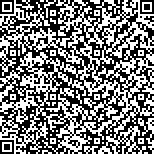| Quote
: |
黄娟,王一阳,肖凡,刘秀,喻嵘.参苓白术散调控TLR4/NF-κB通路抑制LPS诱导心肌细胞炎性损伤的机制[J].湖南中医药大学学报英文版,2023,43(10):1815-1821.[Click to copy
] |
|
| |
|
|
| This paper
:Browser 2486times Download 1099times |
| 参苓白术散调控TLR4/NF-κB通路抑制LPS诱导心肌细胞炎性损伤的机制 |
| 黄娟,王一阳,肖凡,刘秀,喻嵘 |
| (湖南中医药大学第一附属医院, 湖南 长沙 410007;湖南中医药大学, 湖南 长沙 410208) |
| 摘要: |
| 目的 基于Toll样受体4(Toll-like receptor 4, TLR4)/核因子κB(nuclear factor-κB, NF-κB)信号通路探讨参苓白术散含药血清对脂多糖(lipopolysaccharide, LPS)诱导H9C2心肌细胞炎性损伤的调控机制。方法 将分化完全的H9C2心肌细胞分为空白血清组、模型组、参苓白术散含药血清组、TLR4抑制剂(TAK-242)组,每组6个复孔。除空白血清组外,其余各组以10 μg·mL-1 LPS处理细胞,构建心肌细胞炎症损伤体外模型。空白血清组、模型组及TAK-242组以10%空白血清进行培养,参苓白术散含药血清组用10%含药血清培养,均培养24 h。采用CCK-8法测定各组细胞增殖情况;采用ELISA法及免疫荧光法检测细胞白细胞介素-1β(interleukin-1β, IL-1β)、肿瘤坏死因子-α(tumor necrosis factor-α, TNF-α)含量及蛋白表达水平;采用Western blot法检测TLR4、NF-κB、NF-κB抑制蛋白α(degradation of protein κB-α, IκBα)蛋白表达情况。结果 CCK-8法结果发现,10%参苓白术散含药血清对细胞增殖无抑制作用。与空白血清组比较,模型组细胞的TNF-α、IL-1β含量及荧光表达量明显增高(P<0.01),TLR4、NF-κB、IκBα蛋白表达明显上调(P<0.01)。与模型组比较,参苓白术散含药血清组IL-1β、TNF-α含量显著降低(P<0.01),TLR4、NF-κB、IκBα蛋白表达明显下调(P<0.01)。结论 参苓白术散含药血清能抑制LPS诱导的心肌细胞炎性反应,其作用机制可能与调控TLR4/NF-κB通路,下调细胞炎症因子TNF-α、IL-1β表达有关。 |
| 关键词: 参苓白术散 含药血清 H9C2细胞 炎性反应 TLR4/NF-κB通路 |
| DOI:10.3969/j.issn.1674-070X.2023.10.010 |
| Received:April 21, 2023 |
| 基金项目:国家自然科学基金面上项目(82074400);湖南省重点研发计划项目(2020SK2101);湖南省教育厅科研项目(20K094)。 |
|
| Mechanism of Shenling Baizhu Powder in inhibiting LPS-induced inflammatory injury of myocardial cells by regulating TLR4/NF-κB signaling pathway |
| HUANG Juan,WANG Yiyang,XIAO Fan,LIU Xiu,YU Rong |
| (The First Hospital of Hunan University of Chinese Medicine, Changsha, Hunan 410007, China;Hunan University of Chinese Medicine, Changsha, Hunan 410208, China) |
| Abstract: |
| Objective To investigate the regulatory mechanism of medicated serum containing Shenling Baizhu Powder (SLBZP) on lipopolysaccharide (LPS)-induced inflammatory injury of H9C2 myocardial cells based on Toll-like receptor 4 (TLR4)/nuclear factor-κB (NF-κB) signaling pathway. Methods The fully differentiated H9C2 cells were divided into blank serum group, model group, medicated serum containing SLBZP group, and TLR4 inhibitor (TAK-242) group, with six replicates in each group. Except for the blank serum group, cells of the other groups were treated with LPS 10 μg·mL-1 to establish an in vitro model of myocardial cell inflammatory injury. Blank serum group, model group, and TAK-242 group were cultured with 10% blank serum, and medicated serum containing SLBZP group with 10% medicated serum. All groups had been cultured for 24 h. CCK-8 assay was used to test the cell proliferation of each group; ELISA and immunofluorescence were used to determine the content of interleukin-1β (IL-1β) and tumor necrosis factor-α (TNF-α) and their protein expression levels in cells, respectively; Western blot was used to check the protein expression levels of TLR4, NF-κB, and degradation of protein κB-α (IκBα). Results The results of CCK-8 assay showed that 10% SLBZP-medicated serum had no inhibitory effects on cell proliferation. Compared with the blank serum group, the content of TNF-α and IL-1β and their fluorescent expression levels in cells of model group significantly increased (P<0.01), and the protein expression levels of TLR4, NF-κB, and IκBα were significantly up-regulated (P<0.01). Compared with the model group, medicated serum containing SLBZP group showed significantly reduced content of IL-1β and TNF-α (P<0.01) and significantly down-regulated protein expression levels of TLR4, NF-κB, and IκBα (P<0.01). Conclusion Medicated serum containing SLBZP can inhibit the LPS-induced inflammatory response in H9C2 cells. Its mechanism may be related to regulating TLR4/NF-κB pathway and down-regulating the expression of inflammatory factors of TNF-α and IL-1β. |
| Key words: Shenling Baizhu Powder medicated serum H9C2 cells inflammatory response TLR4/NF-κB signaling pathway |
|

二维码(扫一下试试看!) |
|
|
|
|


